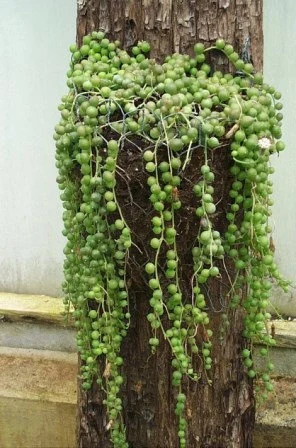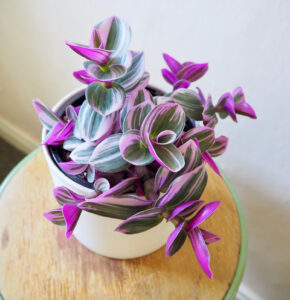The String of Pearls (scientifically known as Senecio rowleyanus) is a unique and visually striking succulent known for its long, trailing stems covered in small, round, bead-like leaves. This succulent is native to dry regions of Africa and is an excellent choice for both novice and experienced gardeners, particularly those who appreciate low-maintenance yet high-impact plants. If you’re looking to care for a String of Pearls, this comprehensive guide will provide you with the necessary steps to ensure your plant thrives in your home or garden.
1. Light Requirements
String of Pearls thrives in bright, indirect light, and it can tolerate a few hours of direct sunlight each day. However, too much direct sunlight, especially in the summer months, can cause the beads (the round leaves) to burn or become discolored. Ideally, the plant should be placed near a window that receives filtered sunlight, like an east or west-facing window.
If your home doesn’t get enough natural light, a grow light can be a good alternative. Keep the light at a moderate level—too much direct light from a grow lamp can also stress the plant.
Signs of improper light:
- If the plant isn’t getting enough light, the stems may become leggy, and the pearls will appear spaced out.
- If the plant is receiving too much light, the pearls may become discolored or shriveled due to sunburn.
2. Watering
One of the most important factors in growing a healthy String of Pearls is proper watering. Overwatering is a common mistake and can lead to root rot, which is often fatal for succulents. These plants prefer to dry out completely between waterings.
Watering tips:
- Water the plant when the top 1-2 inches of soil feel dry to the touch.
- During the growing season (spring and summer), the plant may require watering every 1-2 weeks, but this can vary depending on the temperature and humidity in your home.
- In the winter months (fall and winter), the plant goes into dormancy and needs less water. Watering once every 3-4 weeks is usually sufficient during this time.
- When you water, thoroughly drench the soil and allow any excess water to drain out of the bottom of the pot. Avoid letting the plant sit in water, as this can promote root rot.
Signs of improper watering:
- If the leaves are turning yellow or mushy, the plant is likely overwatered.
- If the pearls are shriveled or dry, the plant is underwatered.
3. Soil
String of Pearls requires well-draining soil to thrive. A regular potting mix often retains too much moisture, which can cause the roots to rot. Instead, use a cactus or succulent potting mix that is specifically designed to allow for good drainage.
Alternatively, you can create your own soil mix by combining:
- 1 part cactus mix or regular potting soil
- 1 part perlite or pumice (to increase drainage)
- 1 part sand (to further ensure good drainage)
The goal is to have soil that dries quickly and does not hold excess moisture.
4. Potting and Container
Choosing the right container for your String of Pearls is important. Ideally, use a pot with drainage holes. This will allow any excess water to escape, preventing root rot.
Choosing the right pot:
- Material: Clay or terracotta pots are ideal because they allow moisture to evaporate faster than plastic pots. However, plastic pots are also fine as long as they have proper drainage.
- Size: Choose a pot that is only slightly larger than the root ball. Succulents prefer to be a little root-bound. A pot that is too large can lead to overwatering, as the soil will take longer to dry out.
5. Temperature and Humidity
String of Pearls enjoys warm temperatures but cannot tolerate cold. The ideal temperature range is between 70°F and 85°F (21°C – 29°C). They can survive in slightly cooler temperatures but should not be exposed to temperatures below 50°F (10°C).
Humidity is not a major concern for String of Pearls since they are accustomed to arid environments. In fact, they prefer lower humidity levels. If your home is particularly humid, make sure the plant has adequate airflow to prevent fungal growth.
Signs of temperature stress:
- If the plant is exposed to temperatures that are too cold, the pearls may shrivel, and the plant may become dormant.
- If the plant is too hot or placed in direct sun for too long, it may begin to burn or show signs of stress like shriveled leaves.
6. Fertilizing
String of Pearls is not a heavy feeder, but occasional fertilization can promote growth. During the growing season (spring and summer), feed your plant once a month with a diluted, balanced liquid fertilizer formulated for succulents. Avoid fertilizing in the fall and winter when the plant is dormant.
How to fertilize:
- Use a water-soluble fertilizer with a low concentration (usually a balanced 10-10-10 fertilizer).
- Dilute the fertilizer to about one-quarter to one-half strength, as too much fertilizer can damage the plant.
- Apply the fertilizer when the soil is slightly moist to prevent fertilizer burn.
7. Repotting
Repotting String of Pearls is usually necessary every couple of years, as they can outgrow their pot. Look for signs that the plant is becoming root-bound, such as roots growing out of the drainage holes or a significant slowdown in growth.
When repotting:
- Choose a pot that is 1-2 inches larger in diameter than the current pot.
- Be gentle with the plant, as the pearls and stems can break easily.
- Be sure to use fresh, well-draining soil to prevent root rot.
8. Pruning and Propagation
String of Pearls is a fast grower, and regular pruning can help keep it neat and encourage new growth. If the plant starts to get too long and leggy, feel free to trim the stems. You can propagate the cuttings to create new plants.
How to prune and propagate:
- Cut the stems back to a desirable length using clean scissors or pruning shears.
- To propagate, place the cuttings in a small pot with well-draining soil, and water sparingly until new roots develop. It’s important to let the cuttings callous over for a day or two before planting to reduce the risk of rot.
- Propagation can also be done in water, but once the roots are established, transfer the cutting to soil for best results.
9. Common Problems and Solutions
- Yellowing or mushy leaves: Overwatering or poor drainage. Let the soil dry out completely between waterings, and make sure your pot has proper drainage.
- Shriveled leaves: Underwatering or too much direct sunlight. Ensure the plant is watered when the top of the soil is dry and adjust the light exposure if needed.
- Leggy growth: This is often a sign of insufficient light. Move your plant to a brighter location or use a grow light to provide supplemental light.
- Root rot: This is the most common problem and occurs when the plant is overwatered or the soil doesn’t drain well. Ensure proper drainage and water only when necessary.
10. Toxicity
It’s important to note that String of Pearls is toxic to pets, especially cats and dogs, if ingested. The plant contains compounds that can cause gastrointestinal upset. Keep it out of reach of curious pets, or opt for non-toxic alternatives if you have animals in the house.
Conclusion
The String of Pearls is a beautiful, low-maintenance succulent that can make a stunning addition to your home or garden. By following these care guidelines, you can ensure that your plant thrives and continues to grow, providing you with its charming, cascading beads for years to come. Remember that moderation is key—avoid overwatering, provide bright but indirect light, and allow the plant to dry out between waterings, and you’ll have a happy, healthy String of Pearls.


